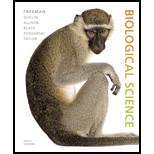
Concept explainers
What synapomorphy (shared, derived trait) distinguishes animals as a monophyletic group, distinct from choanoflagellates?
a. multicellularity
b. coloniality
c. heterotrophy
d. movement
Introduction:
Animals are classified as a monophyletic group (share a common ancestor). The ancestor was multicellular as known from the data records from comparative morphology, fossils, comparative development, and comparative genomics.
Answer to Problem 1TYK
Correct answer:
The multicellularity is the derived trait that distinguishes animals as a monophyletic group and makes them distinct from choanoflagellates. Choanoflagellates are unicellular, free-living, colony-forming eukaryotes, and contain collared flagellates. They are considered to be the closest living relatives of the animals.
Explanation of Solution
Explanation/Justification for the correct answer:
Option (a) is given as multicellularity. Choanoflagellates differ from animals on the basis of multicellularity. Choanoflagellates do not exhibit muticellularity, whereas animals are multicellular organisms. Hence, Option (a) is correct.
Explanation for incorrect answer:
Option (b) is given as coloniality. The organisms exhibit the colonial characteristics, such as protozoa, bacteria, echinoderms, bivalves, and many more. Choanoflagellates are unicellular and are sometimes colonial (due to the presence of bacteria). So, it is an incorrect option.
Option (c) is given as heterotrophy. All the animals are heterotrophs along with fungi. Both the categories are motile. So, it is an incorrect option.
Option (d) is given as movement. This characteristic is not the basis of diversion of animals from choanoflagellates. So, it is an incorrect option.
Hence, options (b), (c), and (d) are incorrect.
The choanoflagellates are the closest relatives of animals, but they are distinguished from animals on the basis of multicellular organization.
Want to see more full solutions like this?
Chapter 30 Solutions
Biological Science (6th Edition)
- 6. A collection of similar genera * a. family b. order c. kingdom d. genusarrow_forwardBased on the diagram, which of the following pairs of organisms have the closest evolutionary relationship? A. Radiolarians and Forams B. Diatoms and Euglenozoans C. Ciliates and Radiolarians D. Diplomonads and Euglenozoansarrow_forwardYou discover a new species of animal that has hair and three inner ear bones. What class would you put it in? Group of answer choices A. Aves B. Mammalia C. Arachnida D. Osteichthyes E. Chordataarrow_forward
- "Stalked jellyfishes" belong to which class? A. Staurozoa B. Scyphozoa C. Anthozoa D.Hydrozoa E. Cubozoaarrow_forwardWhat function do amoeboid cells serve?arrow_forwardA fishing net brings up a soft bodied animal with a coiled external shell. How can you determine whether the animal is a gastropod or a cephalopod? A) give one unique trait that would allow you to identify the organism as a member of class gastropoda. B) give one unique trait that would allow you to identify the organism as a cephalopodarrow_forward
- Which group is correctly paired with its description? A. diatoms-important consumers in aquatic communities B. diplomonads-protists with modified mitochondria C. apicomplexans -producers with intricate life cycles D. red algae-acquired plastids by secondary endosymbiosisarrow_forwardWhich clade does not include humans?(A) synapsids(B) lobe-fins(C) diapsids(D) osteichthyansarrow_forwardCubozoans are______. a. polyps b. medusoids c. polymorphs d. spongesarrow_forward
- What do scientists in the field of systematics accomplish? a. discover new fossil sites b. organize and classify organisms c. name new species d. communicate between field biologistsarrow_forwardWhich statement about the taxonomic classification system is correct? a. There are more domains than kingdoms. b. Kingdoms are the top category of classification. c. A phylum may be represented in more than one kingdom. d. Species are the most specific category of classification.arrow_forward

 Concepts of BiologyBiologyISBN:9781938168116Author:Samantha Fowler, Rebecca Roush, James WisePublisher:OpenStax College
Concepts of BiologyBiologyISBN:9781938168116Author:Samantha Fowler, Rebecca Roush, James WisePublisher:OpenStax College Biology (MindTap Course List)BiologyISBN:9781337392938Author:Eldra Solomon, Charles Martin, Diana W. Martin, Linda R. BergPublisher:Cengage Learning
Biology (MindTap Course List)BiologyISBN:9781337392938Author:Eldra Solomon, Charles Martin, Diana W. Martin, Linda R. BergPublisher:Cengage Learning



